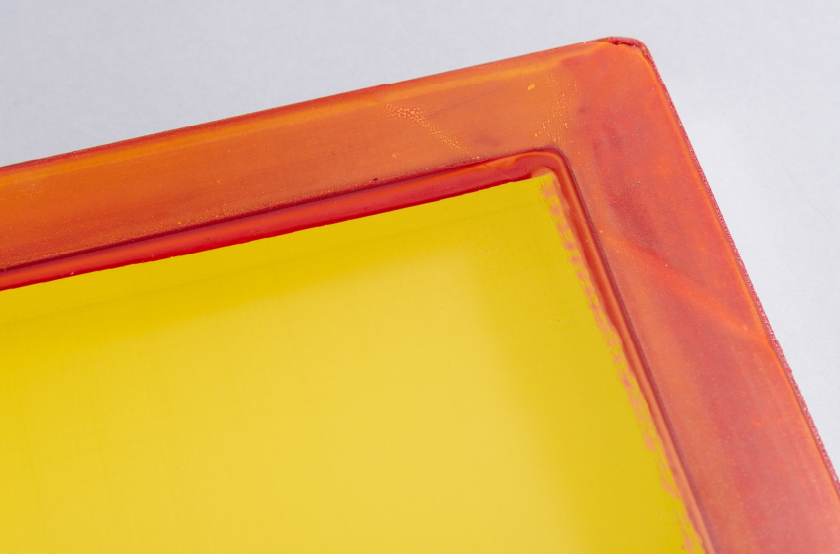Even the most seasoned screen printers will occasionally have to deal with improperly exposed screens. Underexposed screens cause a long list of problems, making it difficult to determine what exactly the issue is, and its cause. Overexposed screens are more straightforward but still far from ideal.
Overexposure can make it so that your exposed screen won’t wash out. This presents its own set of headaches. To mitigate this, we’re going to cover what to do when an exposed screen won’t wash out. More importantly, we will cover how to avoid it in the future.
Can You Expose a Screen for Too Long?
One of the primary causes of overexposure is, as you might guess, too long of an exposure time. Another primary cause is too much UV light. Overexposed emulsions are essentially “cooked” and will not easily come free of the stencil. Exposure time can vary greatly depending on several factors. The type of emulsion being used, the exposure unit, and how much emulsion is applied to the screen are a handful of factors of which to be aware. Additionally, if your film positives or CTS inks are not opaque enough, too much light will come through during exposure, leading to overexposure.

What Happens if You Overexpose a Screen?
The most common and easily detectable sign of overexposure can be seen when the exposed screen won’t wash out, but other signs of an overexposed screen could include significant loss of detail and degraded edges on the print.
An overexposed screen is incredibly difficult to wash out, and nearly impossible in some cases. At first, you may be tempted to use more water or higher water pressure to wash out the screen. However, doing this can result in either the screen being broken or your print’s quality and detail being ruined.
How Do You Rinse an Overexposed Screen?
While using more water may not wash out an overexposed screen, sometimes a screen can be cleaned/reclaimed with bleach (the stronger, hardware or pool bleach, not laundry bleach) or, preferably, an emulsion remover. The process is similar for both products: Apply the emulsion remover to the screen on both sides, and let it sit for about 45-60 seconds before scrubbing thoroughly and washing it out. Do not let it dry entirely.
Whether you opt for bleach or an emulsion remover, letting either dry completely will chemically “lock-in” the emulsion. If this happens, then you’ll be unable to do anything except remake the screen and start over. In fact, if large parts of the screen are overexposed, it may just be cheaper and faster to scrap the screen and start over right away instead of trying to rinse it.
Other Reasons an Exposed Screen Won’t Wash Out
Overexposure is the most common cause of a stencil not washing out, but it is not the only one. For instance, if your coated screen is not stored properly, it can become foggy and leave patches on your image after printing.
Older screens that have been left coated and unused for long stretches of time will be more difficult to expose. Not only are these older, worn screens more prone to fogging, but they’re also more sensitive to changes in storage conditions.
Part of traditional screen printing setups include using a vacuum to remove air from in between your positives and your emulsified screen. If this is not done properly, or if the image isn’t pressed firmly enough against the glass, this may also cause the image to not wash out properly.

How To Avoid Overexposed Screens
While overexposed screens can disrupt the screen printing process, they can be largely avoided. While not perfect, step wedges are a manual method that can help gauge exposure time—assuming your stencil is perfectly opaque. The step wedge test works by taking a time where a screen is sure to be underexposed and exposing it in increments of your choice until it is overexposed.
However, as mentioned earlier, using high-quality equipment can help make the exposure process easier and more calculable. Different exposure units come with different types of light sources, which also affect the exposure process.
What Is the Best Screen Printing Exposure Unit?
For CTS printing systems, EXILE Technologies’ V-Lux easily outperforms traditional exposure units. The V-Lux utilizes a full panel of UV-LEDs to provide even screen exposure while also keeping energy consumption and operating temperatures low. This means the V-Lux will be able to function at peak level years after you’ve bought it.
Even though different types of emulsions require different exposure times, the V-Lux is capable of handling multiple types of emulsions with speed; it can typically expose pure photopolymer emulsions in 10 seconds or less, and both dual-cure & diazo in 20-60 seconds.
There will always be other outliers to account for such as mesh count and emulsion thickness, but the V-Lux is more than capable of reaching these time frames.
EXILE Technologies
Most problems in the exposure process can be avoided with experience and proper equipment. For shops looking to take their production to the next level, the V-Lux screen printing exposure unit offers unbeatable benefits. To find out more about what the V-Lux can do for you, contact the screen printing experts at EXILE Technologies today.






